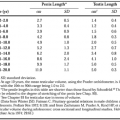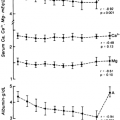EVALUATION OF THE PATIENT WITH THYROID DISEASE
The location of the thyroid makes it readily accessible to both inspection and palpation (Fig. 28-1). Often, the casual detection of a lump or mass in the thyroid by either the patient, a spouse, or an acquaintance first brings the patient in for evaluation. The thyroid examination is a mandatory and routine component of any complete history and physical examination. Aspects of the patient’s clinical history may suggest thyroid dysfunction, in which case a careful thyroid examination is warranted. Symptoms of thyroid dysfunction may be caused by either hypofunction or hyperfunction of the thyroid, or they may be related to neck symptoms resulting from an enlarging nodule or goiter. The clinician then must assess the significance of the patient’s complaints by simultaneously ascertaining both a functional and an anatomic diagnosis. The functional evaluation is based on various components of the history and physical examination, as well as the results of thyroid function tests (which, in general, are outlined in several chapters within this section; specific tests are described in relation to individual disorders that are discussed in separate chapters). The symptoms associated with deficient or excessive thyroid hormone production (Table 28-1) represent the most important and relevant information to be obtained
on history-taking. When taking a history, the clinician should be attentive to the quality of the patient’s voice: the presence of hoarseness suggests involvement of the recurrent laryngeal nerve, slow husky speech is characteristic of hypothy-roidism, and rapid, more staccato cadences often are present in thyrotoxic individuals. Occasionally, patients may have a serum TSH value that is below or above the normal range, suggestive of hyperthyroidism or hypothyroidism, respectively, but have no complaints or discernible symptoms. Often, this represents early or mild disease, which has not yet progressed to either overt symptoms or abnormalities in the levels of thyroid hormones and has been called “chemical,” “subclinical,” or “minimally symptomatic” thyroid disease.33,34 This entity is discussed further in Chapter 42 and Chapter 45. Important aspects of the clinical history in a patient with a goiter or a thyroid mass are discussed in Chapter 38, Chapter 39, Chapter 40 and Chapter 41.
on history-taking. When taking a history, the clinician should be attentive to the quality of the patient’s voice: the presence of hoarseness suggests involvement of the recurrent laryngeal nerve, slow husky speech is characteristic of hypothy-roidism, and rapid, more staccato cadences often are present in thyrotoxic individuals. Occasionally, patients may have a serum TSH value that is below or above the normal range, suggestive of hyperthyroidism or hypothyroidism, respectively, but have no complaints or discernible symptoms. Often, this represents early or mild disease, which has not yet progressed to either overt symptoms or abnormalities in the levels of thyroid hormones and has been called “chemical,” “subclinical,” or “minimally symptomatic” thyroid disease.33,34 This entity is discussed further in Chapter 42 and Chapter 45. Important aspects of the clinical history in a patient with a goiter or a thyroid mass are discussed in Chapter 38, Chapter 39, Chapter 40 and Chapter 41.
Stay updated, free articles. Join our Telegram channel

Full access? Get Clinical Tree






